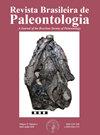Quaternary proboscidean (Mammalia) remains of the UIS Geological Museum, Colombia
IF 0.7
4区 地球科学
Q4 PALEONTOLOGY
引用次数: 3
Abstract
Proboscideans arrived in South America from North America during the Great American Biotic Interchange, becoming one of the most representative animals of the megafauna thatinhabited this continent throughout the Quaternary. In Colombia, the abundance of their remains contrasts with scarce scientific descriptions and publications. This paper identifies dental and postcranial proboscidean fossils from the Center and Northeast of Colombia. The fossil remains were identified as molars (six), a tusk, cervical vertebrae, and a distal part of the right humerus. The tusk was assigned to Notiomastodon platensis, while the other remains were assigned to Gomphotheriidae, with at least six individuals: two immatures, two subadults, and two older adults–mature and senile. Keywords: South America, megamammals, taxonomy, Gomphotheriidae, Notiomastodon platensis.哥伦比亚美国地质博物馆第四纪长鼻目(哺乳类)遗迹
在美洲生物大交换期间,长鼻动物从北美来到南美洲,成为第四纪整个大陆上最具代表性的巨型动物之一。在哥伦比亚,他们丰富的遗骸与稀少的科学描述和出版物形成鲜明对比。本文鉴定了来自哥伦比亚中部和东北部的牙齿和颅后鼻类化石。化石残骸被鉴定为臼齿(六颗)、一根象牙、颈椎和右肱骨的远端部分。象牙归属于platensis Notiomastodon,而其他遗骸归属于Gomphotheriidae,至少有6个个体:两个未成熟,两个亚成年,两个成熟和衰老的老年人。关键词:南美,巨型兽类,分类学,gomphothiidae, Notiomastodon platensis
本文章由计算机程序翻译,如有差异,请以英文原文为准。
求助全文
约1分钟内获得全文
求助全文
来源期刊

Revista Brasileira De Paleontologia
PALEONTOLOGY-
CiteScore
1.60
自引率
14.30%
发文量
25
审稿时长
>12 weeks
期刊介绍:
It publishes original contributions on all aspects of Paleontology. Papers are written in English, Spanish, or Portuguese and are reviewed by international experts.
 求助内容:
求助内容: 应助结果提醒方式:
应助结果提醒方式:


